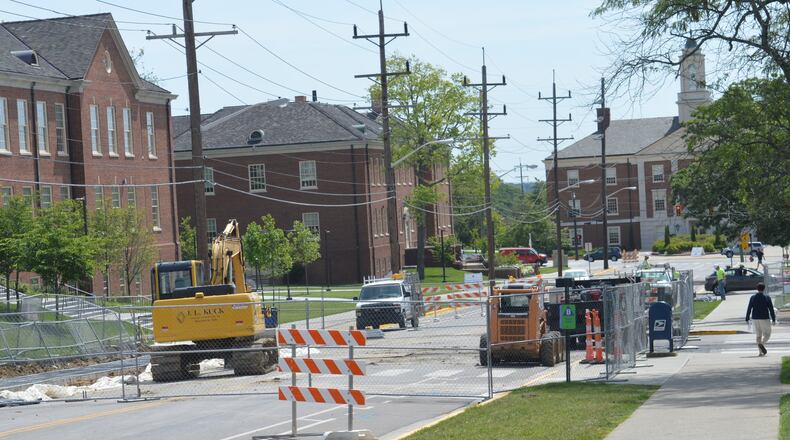The intersection will have a “raised table” with a rise of three to six inches. It is intended to slow vehicular traffic through there, which engineers say will make drivers more aware of pedestrians.
The recommendations were the result of a traffic study — pedestrian and vehicle — contracted by Miami University throughout several areas of the campus.
The engineering study showed 10,000 pedestrian crossings a day at Spring and Maple streets and that number is expected to rise with the opening of the east wing of the Armstrong Student Center and the Center for Career Exploration and Success. Also expected to open in August is a package distribution center in the Shriver Center, expected to further increase pedestrian crossings.
It is the three-way stop planned for that intersection that has generated the most discussion and was the cause for reconsideration at a recent city council meeting.
The resolution to authorize Miami to proceed with the plan first appeared on the May 16 Council agenda when no representatives of Miami University were in attendance. The resolution was presented by city Service Director Mike Dreisbach, who noted a proposal for a three-way stop there was rejected by Council several years ago but was done without a study of the pedestrian and traffic counts.
With a study now done, he said, Miami University was returning with the plan to remake the intersection.
“All the improvements are 100 percent funded by Miami University,” he said.
He also noted Maple Street was already being torn up due to water main improvements.
With regard to the intersection, however, Dreisbach said the usage numbers meet state requirements for a three-way stop at all hours of the day.
Former council member Dick Keebler, however, spoke from the audience and objected, saying a traffic light is a better option because it would better regulate flow of vehicles and pedestrians. He said he opposed the three-way stop when he was on council and has not changed his mind.
“What we do not need is more stop signs choking traffic flow,” Keebler said, adding there are already stop signs at Spring and Oak and Spring and Campus. “Students take advantage of stopped cars. What we have is a solution looking for a problem.”
Council members agreed with him at that meeting and voted 5-1 to amend the resolution to eliminate the three-way stop item but approving all the other changes.
“I agree with everything else, but not the stop signs,” said council member Glenn Ellerbe. “I believe what Mr. Keebler said is true. We’ll have gridlock.”
Mayor Kate Rousmaniere was the lone dissenting vote.
With that change, the resolution passed on a 6-0 vote, with council member Bob Blackburn absent from the meeting.
City Manager Doug Elliott was out of town for the June 6 council meeting and Economic Development Director Alan Kyger filled in for him, bringing a resolution repealing that May 16 action and reinstating the original resolution as presented, complete with the three-way stop.
Kyger said he thought it appropriate to bring it back for discussion since Miami University representatives were present to make their case for the changes.
John Seibert, Miami University’s director of planning, architecture and engineering, said the overall counts at the intersection were not even close to the warrants needed for a traffic light.
“With 8,000-plus crossing there, you have a virtual stop now,” Seibert said. “Signals increase rear-end collisions.”
Keebler again stated objections to the idea of stop signs and argued for a traffic light.
“I still do not understand how the numbers do not point to a traffic signal,” he said. “Taking turns is something students do not seem to understand.”
Cody Powell, Miami’s associate vice president for facility planning and operation, was also present at the June 6 meeting and said the study included 18 campus intersections and showed a total of 180,000 pedestrian crossings a day, campus-wide.
“We try to find a solution that works best for pedestrians and traffic (at Spring and Maple). A traffic light could be installed. I am not particularly opposed to that,” Powell said. “I don’t think stop signs change the high-volume times. There are times when students are not there and waiting at stop signs is not as big an irritant as a traffic light.”
Ellerbe said traffic lights, however, can be programmed to flash at low-volume times rather than stopping traffic from moving.
“I think a traffic signal solution is the most elegant solution to a somewhat controversial situation,” Ellerbe said.
The “controversial” part of that comment played out in the vote by council. No amendment was proposed this time, leaving the resolution on a straight vote.
With two members of council — Blackburn and Edna Southard — missing this meeting the vote was 3-2 with Steve Dana, Mike Smith and Rousmaniere voting in favor and Ellerbe and Kevin McKeehan opposing it.
City Law Director Steve McHugh, however, said he needed to do some quick research after which he declared the resolution was passed. The confusion arose from the fact ordinances require at least four votes to pass. After reviewing the charter, however, he said it is silent on resolutions, meaning a simple majority of those present can approve it, not a majority of the seven-member council.
About the Author
